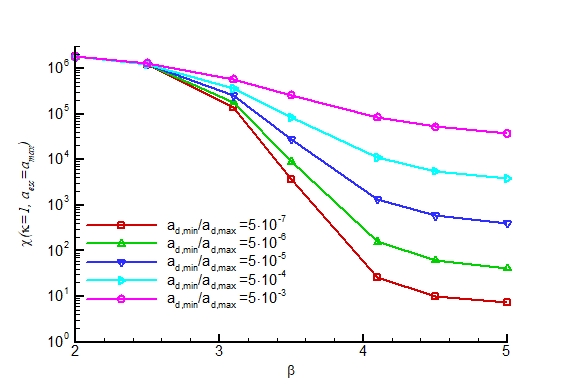Maximum dust-to-gas mass flux ratio in spherically expanding dusty-gas flow.
- 1LESIA, Observatoire de Paris, Universite PSL, CNRS, Sorbonne Universite, Universite de Paris, Meudon, France (vladimir.zakharov@obspm.fr)
- 2Peter the Great St.Petersburg Polytechnic University, St.-Petersburg, Russia
- 3RFNC- VNIIEF - Russian Federal Nuclear Center All-Russian Research Institute of Experimental Physics, Sarov, Russia
- 4INAF - Osservatorio Astronomico, Trieste, Italy
- 5INAF - Osservatorio Astronomico Capodimonte, Napoli, Italy
- 6Università degli Studi di Napoli Parthenope, Naples, Italy
Maximum dust-to-gas mass flux ratio in spherically expanding dusty-gas flow.
In the context of an increasing number of complex multiparametric dusty-gas coma models it is convenient to address the analysis of complex physical phenomena in a step-by-step manner. We construct a set of elementary models with a minimum number of parameters selected to represent the key processes acting in a dusty gas coma. Such kind of models enables studies of generic processes occurring in variety of particular cases in order to reveal their characteristic features.
In many models of dusty-gas atmosphere of comets the dust-to-gas mass flux ratio is a free parameter. In order to constraint the range of possible values of this parameter, in the present work we propose an estimate of its maximum value. We consider a “pedagogic” case which assumes a homogeneous spherical nucleus and spherical expansion of dusty-gas (as an elementary model of the coma). The dust grains are assumed to be homogeneous spheres with size distribution given by a power law n(ad) ∝ ad-β.
After ejection from the surface dust grain is accelerated by the gas flow in the gravitational field of the nucleus. In the present consideration we assume that the radiation pressure due to solar illumination of the grain is negligibly small. With increasing distance to the nucleus the gas drag and the nucleus gravitational attraction decrease and decoupling of gas and dust flows occurs at some distance. In absence of other forces, the dust grains continue motion with constant “terminal velocity”. As was shown in [1], the dust grains reach 90% of the terminal velocity at cometocentric distance about 6 comet radii.
The numerical integrated terminal velocity of dust grains in a spherically expanding flow is given in [1] for a wide range of conditions. The terminal velocity (vd) can be approximated as:
vd(ad)/vmax=Ai IvBi, i=1,2,3,
where Iv is a dimensionless parameter characterizing the efficiency of entrainment of the particle within the gas flow (see [1]), vmax is the theoretical maximal velocity of gas expansion, and Ai, Bi are coefficients of approximation defined for three non-overlapping ranges of parameter Iv variation.
To escape the gravitational attraction of the nucleus terminal velocity of the dust particles should exceed the escape velocity vesc. This condition combined with the approximation for the terminal velocity allows us to derive the maximum size of the grains that reach escape velocity.
The dust mass loss rate qd of grain size ad and the gas production rate qg are related via:
qd(ad)=χfmd(ad) qg dad,
where χ=Qd/qg is the dust-to-gas mass loss rate, Qd is the dust mass loss rate integrated over all grain sizes, and fmd is the normalized mass distribution of dust grains.
Considering the foregoing, for the cometocentric distances greater than 6 comet radii it is easy to derive the energy fluxes of gas and dust flows.
The dust flow gets energy from the gas flow. Therefore, the maximum dust-to-gas mass loss rate corresponds a certain fraction of gas flow energy (κ<<1) being transferred in the dust flow energy.
In simplified form the expression for the maximum dust-to-gas mass loss rate is:
χ=κ(vmax/vesc)2 (amax/aesc)4-β (3-β)/(4-β) [1-(amin/amax)4-β]/[1-( amin/aesc)3-β].
Fig.1 shows dust-to-gas mass flux ratio χ as a function of size distribution (β) for the case of a comet with nucleus radius Rn=1 km, mass Mn=1012 kg, vmax=1 km/s, and κ=1. Note, that complete transfer of gas energy to the dust (κ=1) is not physically possible. In addition, in our reasoning it was assumed that the dust does not affect the gas flow, therefore the values of κ should be rather small. The Fig.1 shows that if the ejected dust has a broad range of sizes ad,min/ad,max (e.g. 5-6 orders of magnitude) and β>3.5, the maximum possible dust-to-gas loss rate is rather restricted.

In our presentation, we show an extension of this approach to the more realistic multidimensional case as well.
Acknowledgments
The work of N.Y.Bykov and A.V.Rodionov was supported by the Russian Science Foundation (grant No. 24-12-00299).
The work of A.Rotundi and V.Della Corte was supported by the Italian Space Agency (ASI) within the ASI-INAF agreements I/032/05/0, I/024/12/0 and 2020-4-HH.0.
References
1. V.V. Zakharov, S.L. Ivanovski, J.-F. Crifo, V. Della Corte, A. Rotundi, M. Fulle. Asymptotics for spherical particle motion in a spherically expanding flow. Icarus 312 (2018)
How to cite: Zakharov, V., Bykov, N., Rodionov, A., Ivanovski, S., Della Corte, V., and Rotundi, A.: Maximum dust-to-gas mass flux ratio in spherically expanding dusty-gas flow., Europlanet Science Congress 2024, Berlin, Germany, 8–13 Sep 2024, EPSC2024-230, https://doi.org/10.5194/epsc2024-230, 2024.